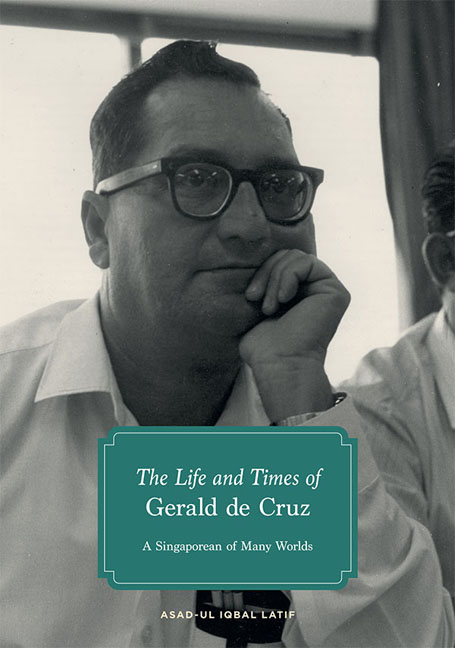Book contents
- Frontmatter
- Dedication
- Contents
- Preface
- Family Tree: Gerald Evelyn de Cruz
- 1 Don de Cruz de la Singapura
- 2 Childhood and Youth
- 3 The Japanese Occupation
- 4 The Communist Years
- 5 Going Abroad
- 6 The English Years
- 7 Return to Singapore
- 8 The Political Thinker
- 9 Friend of Labour
- 10 The Columnist
- 11 The Family Man
- Appendix
- Index
- About the Author
- Plate section
2 - Childhood and Youth
Published online by Cambridge University Press: 19 May 2017
- Frontmatter
- Dedication
- Contents
- Preface
- Family Tree: Gerald Evelyn de Cruz
- 1 Don de Cruz de la Singapura
- 2 Childhood and Youth
- 3 The Japanese Occupation
- 4 The Communist Years
- 5 Going Abroad
- 6 The English Years
- 7 Return to Singapore
- 8 The Political Thinker
- 9 Friend of Labour
- 10 The Columnist
- 11 The Family Man
- Appendix
- Index
- About the Author
- Plate section
Summary
Gerald Evelyn de Cruz was born in Singapore on 20 February 1920. He announced his arrival with a bang. To celebrate the advent of Chinese New Year, the family's neighbours were exploding thousands of red packets of firecrackers. It was a fitting start to a life that would be marked by one explosion after another — personal, national and global.
Gerald de Cruz was born to Cecil Thomas de Cruz and Evelyn Woodford, into a staunchly Roman Catholic family of Eurasian ancestry. He was the eldest of four children, followed by two brothers, Dudley and Guy, and a sister, Hazel. His ancestors had arrived in Singapore in 1824, just five years after Stamford Raffles had founded the city. “On my father's side, we were a mixture of Portuguese and Irish and Indian, and some people say, some Persian blood too, which perhaps gives me my Semitic nose. On my mother's side, we were a mixture of English and Dutch and Chinese”, he recalled.
De Cruz's family was a lower-middle-class one. The whole of the land from East Coast Road to the sea and between Chapel Road and Sea Avenue had belonged to his mother's grandfather, who had given a third of it to the Roman Catholic Church. It built the Church of the Holy Family in Katong on that land. Town Eurasians lived mostly in Queen Street, but outside town the community congregated in two main areas. One was in Katong, where there were the Catholic Eurasians, and the other was at Serangoon and Upper Serangoon, where there were the Anglican and Methodist Eurasians. The latter considered themselves a cut above the others because they were of British stock, whereas the Catholics were of Portuguese descent.
Eurasians were not only early residents of Singapore, Myrna Braga-Blake writes, but they also made it their home. Thus, by 1931, 77 per cent of Singapore's Eurasians had been born in Singapore — more than twice the proportion of the locally born among the Chinese, and five times that of the Indian community. “In the characteristically migrant population of the time, Eurasians stood out as a community with Singaporean roots.”
- Type
- Chapter
- Information
- The Life and Times of Gerald de CruzA Singaporean of Many Worlds, pp. 9 - 18Publisher: ISEAS–Yusof Ishak InstitutePrint publication year: 2015

